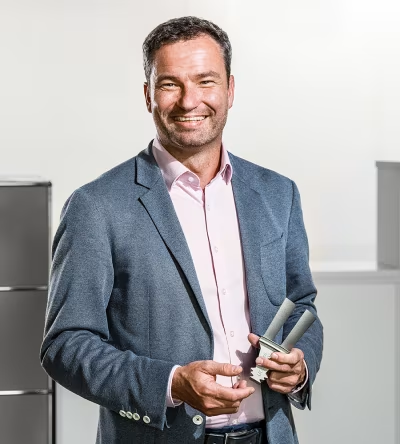Professor Schneider, you are a specialist for smart materials. What does that term actually mean?
Smart, or “intelligent”, materials represent a very broad field which is closely linked to the truly great questions of our time – the environment, energy, mobility and health. In general, these are materials which react to changed conditions with no need for human intervention. I deal specifically with so-called self-reporting materials, or materials that communicate.
Communicative materials – could you elucidate on that a bit?
Here is a good example: When you go to the doctor, he or she measures various vital functions of your body – pulse, blood pressure and so on. Based on this data, the doctor can tell how your body is doing. Self-reporting materials work in a similar fashion. In the future, materials and even entire machines will be able to “report” how they are doing.
The foundation for our research is provided by so-called self-healing materials. One of the basic problems in technical structures is material fatigue. Take an aircraft engine as an example: The components in the turbine are attacked by sand and other particles in the air and over time, cracks form on their surfaces. If a so-called healing agent is introduced into the surface coating, it reacts as soon as a crack opens up because this causes the healing agent to come into contact with oxygen. Through the resulting chemical reaction, the crack is closed and thereby healed.
In the event that this “healing process” causes a change in a property that can be measured, then it is only a relatively small step to a communicative material.
How do these materials communicate then?
We achieved an initial breakthrough in 2003 when we were able to synthesize a material which becomes magnetic when chemically altered. The magnetization, or the strength of the magnetic signal, then delivers a report to us concerning its vital functions, if you will. The further the “healing process” has progressed, the less magnetic it is (provided that the healing products do not contribute to the magnetic signal). The principle is similar to the now outdated cassette recorder which converts the magnetic information on the cassette tapes into music.
What does that mean for industry?
Self-healing and communicative materials represent a paradigm shift for the area of machine design. If materials can heal themselves and both the materials and entire machines can report their condition, engineers are able to go closer to the limits with their designs. Reserves which are necessary today would then hardly or no longer have to be factored in to the design calculations. Concretely, this means that components and machines will become lighter and consequently a car or an aircraft, for example, would need to move less mass, which in turn will lead to significant savings, such as in fuel.
But I am also thinking about other possibilities which arise when machines or devices can communicate actively. A drill, for example, could issue a report before its service life expires – preferably directly to the coating company and not just to the user. Or a wind turbine would report to an engineer’s mobile phone when it needs to be serviced; technicians would then only need to take action when it is really needed, and, with the relatively exposed work site involved, the advantages here are self-evident.
Communicative materials also mean that today’s customary maintenance intervals would be omitted – humans would only intervene when it actually became necessary.
Will this future also affect the professional profile of material scientists?
And how! We are already talking today about “industry 4.0” in which everything is networked and the parts all communicate with each other. Huge amounts of data are being collected and in the future, industry will function with a great deal more precision than today, thanks to these data. Everything will operate according to plan and resource efficiency will be maximized. This holds enormous potential for the industry. But even today, we can already see that the data amounts being generated are not always used optimally. That means it is not enough to just collect the data, but the relevant data must also be examined critically so that processes and materials can be optimized. The interfacing of materials sciences and data, including material, production and performance data, will give rise to a new profession, a new profile for materials scientists. It will no longer be sufficient to know the material – simulation and data analysis will become increasingly important. One great challenge is sure to be the data analysis and the filtering of those data which are definitive for performance.
Hmmm, that’s sounding a bit dry...
(Laughs) Yes, well, I have to admit: In the past few decades materials science has become more and more calculation oriented. This is demanding and often not easy to communicate effectively. Nonetheless, we are having no trouble recruiting a new generation. This year alone, almost 250 new students in Aachen have enrolled for a study programme in the area of materials technology. Our doctoral candidates are sometimes taken under contract by companies even before they have graduated.
Universities in German-speaking regions practice the unity of research and teaching. This is an advantage of inestimable value when it comes to remaining on the cutting edge of new developments and the needs of industry. In Aachen, teaching staff are appointed who are working with new topics and therefore pass these on to the students, thereby completing the cycle. The same thing applies for the topic of smart materials.
And what do you see coming for the future of materials sciences, let’s say in the year 2040?
Of course, I’m not able to see the future, but there is a topic which I find extremely exciting, however also very difficult to predict. Nonetheless, it is one we will all be dealing with: the broad theme of materials in connection with health and medicine.
A short time ago, I was present at a test in which the doctoral candidate made a case for the production of human organs using 3D printing. If you take this idea a bit further, you soon arrive at a point where humans would be able to print their own “spare parts” – a kidney here, an eye there – and could possibly become 150 years old as a result, or even more. It would then no longer be very far from there to the cyborg.
Of course, this is still a long way in the future. However even now, materials scientists are already working on surface solutions for implants designed to be inserted into the human brain. There, they are to measure brain waves with which a robot can be controlled – or by means of which quadriplegics who are unable to move their arms and legs could operate their own wheelchair. Just how “cyber engineering” will impact the development of the human race cannot yet be predicted.
As I mentioned, these are future scenarios which we all will certainly not live to experience. But they touch on questions with which materials science must begin dealing already today – including their moral implications.
Professor Schneider, thank you for this interview!


